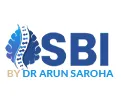Atlanto Axial Dislocations Treatment in India

What is Atlantoaxial Dislocation?
Atlanto-axial dislocation (AAD) is a condition characterized by a misalignment or instability between the first and second cervical vertebrae, the atlas, and the axis. This misalignment can result in severe neurological deficits due to compression of the spinal cord and associated nerve structures. AAD is a critical condition that requires immediate and precise medical attention to prevent long-term disability.
The atlantoaxial complex is primarily responsible for
- Rotation of head
- Enabling the neck to turn left and right.
- Guarding the spinal cord against injury.
Because of its role in the movement, it is unfortunate that this atlantoaxial complex quickly gets prone to injury.
Symptoms and Clinical Presentation
Patients with atlanto-axial dislocation often present with a variety of symptoms, which can vary in severity depending on the degree of dislocation and nerve compression. Key symptoms include:
- Neck pain and stiffness
- Occipital headaches
- Reduced range of motion in the neck
- Neurological deficits such as numbness or weakness in the limbs
- In severe cases, difficulty breathing or swallowing
Causes and Risk Factors
Atlanto-axial dislocations can occur due to a variety of reasons:
Congenital Abnormalities
Some individuals are born with structural defects in their cervical vertebrae.
Traumatic Injuries
Accidents such as vehicular collisions or falls can lead to AAD.
Inflammatory Diseases
Conditions like rheumatoid arthritis can weaken the ligaments in the neck, leading to instability.
Genetic Disorders
Certain syndromes, like Down syndrome, are associated with an increased risk of AAD.
Atlantoaxial Dislocation & Atlantoaxial Subluxation Diagnosis and Treatment in India
The human body is intricately designed, featuring an extensive network of nerves. Among the most delicate and vital parts is the spine, which houses the spinal cord—a crucial nerve bundle that facilitates communication between the brain and the rest of the body. Encased within a protective membrane, the spinal column shields the spinal cord with its vertebrae. Damage to these vertebrae demands meticulous care and specialized treatment.
Atlantoaxial dislocation, though rare, poses significant risks and affects certain patient groups more frequently. Various factors contribute to this condition, and understanding the root causes or predisposing elements is essential for timely and effective intervention. Both anterior and posterior surgical methods are employed for atlantoaxial fusion, each with specific indications, contraindications, associated risks, and levels of complexity. Ongoing and future clinical trials are crucial to determine the most effective surgical approach based on individual patient conditions. For professional care in managing Atlantoaxial dislocation, Atlantoaxial subluxation, and Rotatory subluxation C1 C2, consult Dr. Arun Saroha in Gurgaon, India.
Why You Need Treatment for Atlantoaxial Dislocation ?
- Minimally Invasive: The surgery involves only small incisions, leading to minimal scarring.
- High Success Rate: Success rates for Atlantoaxial dislocation treatment in India surpass those seen in many other countries.
- Quick Recovery: Patients typically experience a faster recovery period.
- Reduced Blood Loss: The procedure is characterized by minimal blood loss.
- Cost-Effectiveness: The cost of Atlantoaxial dislocation treatment in India is considerably lower than in other nations.
How do doctors test for Atlantoaxial dislocation?
- History and Physical Exam: The doctor asks about the injury, symptoms, and checks for neck tenderness, limited movement, and neurological issues.
- Imaging Studies:
- X-rays: Initial test to look for misalignment between the C1 and C2 vertebrae. Special views assess different aspects of potential instability.
- CT Scan: Shows detailed bone structure, helpful for seeing fractures and complex displacement.
- MRI: Best for evaluating the spinal cord, ligaments, and other soft tissues. This is urgent if spinal cord compression is suspected.
Post care for Atlantoaxial dislocation treatment
After surgery for Atlantoaxial dislocation, you'll likely spend a short time in the ICU and then stay in the hospital for about a week. Walking often starts shortly after surgery. Once discharged, you'll need to stay nearby for follow-up appointments for 10-15 days. A neck brace will help stabilize the area, and physical therapy will be essential to regain strength and movement. Pain management is important, and your surgeon will give you specific instructions about activities to avoid. Contact your doctor immediately if you experience new or worsening symptoms.
Recovery of Atlantoaxial Instability (or SubLuxation)
Recovery from Atlantoaxial Instability/Subluxation depends on the severity of your case and the treatment you receive. For non-surgical treatment with a neck collar, improvement may be seen within weeks, while full recovery with physical therapy could take several months. Surgical treatment (spinal fusion) involves a longer recovery process that includes a hospital stay, neck brace, and extensive physical therapy. Recovery from surgery might take several months to a year.
Factors like the severity of your instability, the presence of neurological issues, your overall health, and how well you follow your doctor's instructions will all influence your recovery timeline. Discuss your specific situation with your doctor for the most accurate idea of what to expect.
Why Choose Dr. Arun Saroha for Atlantoaxial Dislocation in India?

When considering Atlantoaxial dislocation Treatment in India, Dr. Arun Saroha is one of the most trusted and renowned spine surgeons. With over two decades of experience in treating complex spinal conditions, Dr. Saroha has successfully performed numerous scoliosis surgeries, helping patients regain their quality of life. He is known for his patient-centric approach, taking the time to understand each case individually and developing personalized treatment plans that prioritize safety, comfort, and long-term outcomes.
Dr. Saroha's expertise in minimally invasive spine surgeries ensures that patients experience less pain, quicker recovery times, and reduced risks of complications. His advanced surgical techniques, coupled with cutting-edge technology, make him a top choice for patients seeking the best possible care for scoliosis. Whether you're in need of bracing, physical therapy, or spinal fusion surgery, Dr. Saroha provides comprehensive care throughout every stage of the treatment process.
Frequently Asked Questions
Consult Dr. Arun Saroha, an expert back pain treatment doctor in India
Get the best back pain treatment consultation
